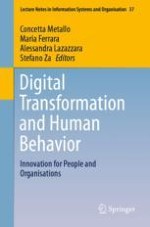2021 | OriginalPaper | Chapter
Human or Machine? A Study of Anthropomorphism Through an Affordance Lens
Authors : Dana Lunberry, Jonathan Liebenau
Published in: Digital Transformation and Human Behavior
Publisher: Springer International Publishing
Activate our intelligent search to find suitable subject content or patents.
Select sections of text to find matching patents with Artificial Intelligence. powered by
Select sections of text to find additional relevant content using AI-assisted search. powered by
